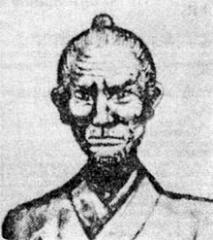 |
The exact origins of Karate are not really known, mostly because in the past, the art was kept secret from outsiders, and no written records were ever kept. We do know the location, however: a small country south of Japan, formerly known as the Kingdom of the Ryukyus. Today, it is known as the Okinawa Prefuncture.
Weapons Banned in the Ryukyus Until the early fifteenth century, the Ryukyus were split into three independent kingdoms - Chuzan, Nanzan, and Hokuzan. These kingdoms were each struggling with the other two for dominance, until finally, Chuzan prevailed. The country was united under its king, Sho Hashi [1372-1439], who immediately after attaining power, established a non-military government. He issued an edict strictly prohibiting the possession of weapons, and called together statesmen and scholars from all over the nation to form a truly centralized administration.
The country lived in undisturbed peace for the next two hundred years. Then, in 1609, the country was attacked by the Shimazu (the military governors of the Satsuma fief in southern Kyushu, who considered the southern seas part of their domain). During Japan's civil war period [Sengoku, 1467-1568], the Shimazu forces had acquired an unequalled reputation for valour and ferocity. Only twenty or so years prior to their attack on the Ryukyus, they had given the great Imperial Regent, Toyotomi Hideyoshi, a very difficult time in his attempts to unify Japan.
The formidable Satsuma samurai met with remarkably stiff resistance when they attacked the Ryukyus. A direct frontal assault on the port of Naha, the gateway to Okinawa, failed, and it was only after a detached force of the Shimazu army circled the island and made a surprise attack on the unguarded port of Unten that the invaders were finally able to gain a foothold. The situation then took a sudden turn for the worse, and Okinawa soon fell into Shimazu hands.
Under the Shimazu, weapons were again banned, this time for the general populace and the upper classes alike. Most historians agree that Karate, the unique Okinawan form of weapon less combat, owes its creation to this second ban, because it forced the Ryukyus to invent a means of unarmed self-defence. However, some weapon less combat techniques must have been practiced before the Satsuma invasion, and so it is likely that this latest invasion simply spurred refinement of already existing techniques.
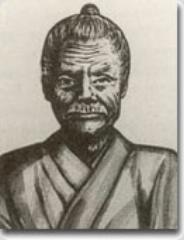 |
Origins of the Ryukyu's Unarmed Techniques Since the Ryukyus were a tributary state of China, there had been periods of frequent contact between them and Fukien on the mainland. It is quite reasonable that Chinese kenpo [lit. "fist method"] had been imported into the islands. Elements of kenpo were probably adapted and incorporated into indigenous fighting styles. Of course, some kenpo styles may also have been passed down intact, retaining their original forms. In this manner the two precursors of Karate-do, Okinawa-te and To-de, were eventually born. It is quite reasonable to assume that To-de referred to fighting forms embodying the Chinese kenpo tradition, and Okinawa-te to native combat techniques.
The history of martial arts in China can be traced back at least six thousand years. It is said that during the reign of the mythological Yellow Emperor [Huang-ti, ca. 2700 B.C.], soldiers fought off barbarian insurgents with razor-sharp swords. From then until the reign of King Wen [Wen Wang], founder of the Chou dynasty [ca. 1027 B.C.], China was in an extremely turbulent state, marked by ongoing warfare among nomadic tribes.
During this period of strife, new stratagems and fighting techniques were constantly being invented out of a natural need to overcome enemies on the battlefield. These ancient fighting methods were systematized primarily through the efforts of three men, Ta-Shang Lao-ch'un, Ta-yi Chen-jen and Yuan Shih-t'ien, who founded what could be called the Three Primitive Schools of martial techniques. Their systems were passed down through generations of disciples, who added improvements and eventually came up with the highly refined techniques of today.
In the Three Kingdoms period [A.D. 220-80], three famous heroes, Kuan-yu, Chang Fei and Chao Yun, were able to rise in the world and perform great deeds for their countries through their prowess in martial techniques. Especially notable was Chao Yun, who, armed only with a spear, was able to drive back throngs of foes and lead his prince to safety. In succeeding periods, it became axiomatic that the commanders of large armies be men who excelled in the skills of their trade and who were very clearheaded and accomplished in strategy.
The next millenium witnessed the gradual evolution of two major styles: Shang Wu and Shaolin. Throughout the Yuan [1279-1368], Ming [1368-1644] and Ch'ing [1644-1912] dynasties, adherents of the two styles competed in polishing and perfecting them, in the process forming a number of branch schools. Needless to say, Shang Wu and Shaolin have their own particular strengths and weaknesses, and it is impossible to say which is superior. In China, these arts were practiced openly, and by the end of the Ch'ing dynasty they had become widely diffused among the general population. Eventually, they came to be looked upon with pride as national traditions.
The Shang Wu style founded by Chang-sen Feng places primary emphasis on the power of ch'i (ki in Japanese). T'ai ch'i, Hsing-i and Pa-kua are good examples of schools exhibiting characteristics of this style. In appearance, their movements have in them an explosive power which, applied correctly, can easily knock a man down.
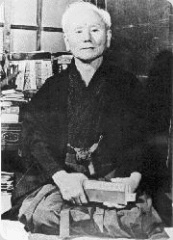 |
The Shaolin style looks upon Ta-mo Lao-tsu [Bodhidharma] as its founder. In this style, which stresses the practical application of hand and foot techniques for blocking and attacking, are seen hard-soft and long-short techniques, that is, both thrusting and short, snapping techniques.
The methods of training employed in the Shaolin style teach how to strengthen the mind and body according to the Ekikin and Senzui sutras. Senzui refers to "washing away the dust of the mind" to uncover its true light. Ekikin, which is composed of characters reading eki ["change"] and kin ["muscle"], means to "discipline and toughen the body ". It is said that these two sutras together give one the power to move mountains and the ki to envelop the universe.
This method of training was the original form of training in the martial arts. The Shaolin style of kenpo eventually spread throughout China and it is still popular there today. It crossed the sea to the Ryukyus, where it probably blended with those indigenous forms it most closely resembled.
The Need for Secrecy With weapons banned, the practice of weapon less combat methods was soon shrouded in secrecy, for the Ryukyus were understandably reluctant to have it known that such things even existed. Fighting methods, and especially matters pertaining to Karate instruction and training, where kept carefully concealed from the eyes of the Satsuma suzerains.
This practice is not confined to Karate; kendo and many other martial arts share this characteristic. However, the others pale in comparison to the great lengths taken by the Ryukyus to guard their art; which included a self-imposed ban against keeping written records. In the Meiji period [1868-1912], when the need for concealment no longer existed, the centuries-old tradition of keeping Karate practice and instruction secret remained deeply rooted among the people.
Virtually nothing is known about those who created Karate and how it was transmitted because of this secrecy. What little is known is known only due to word of mouth, and even then was kept exasperatingly vague. There were no dojo like there are today and no professional instructors. The famous teacher Matsumura was a military officer serving the Ryukyuan king, and Uehara, who is said to have challenged Matsumura to a match, was a metal craftsman. Master Azato, who Funakoshi trained under, was a tonochi, a position similar to being lord of a small fief. Itosu, who Funakoshi learned the Heian, Tekki, and other kata from, was the private secretary to the Ryukyuan king.
This custom of secrecy persisted in Okinawa until the 1950's. This helps explain why there are such widely different
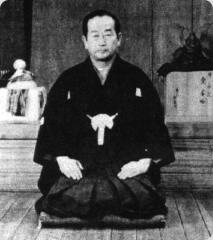 |
variations in what was originally a single kata. In addition, there is always the potential problem of a student's misinterpreting a kata, thereby altering its transmission and causing distortions.
In Okinawa 3 separate styles or Te emerged. These styles are named for the regions in which they were developed. The styles are Shuri-Te, Tomari-Te, and Naha-Te. The differences in these styles suggests influences from various Chinese styles. Shuri-Te seems to have incorporated the external system of Shaolin boxing, while Naha-Te incorporates internal Taoist techniques (possibly Hsing-I or Pa-kua influence). Tomari-Te seems to have had a mix of both internal and external styles. The Chinese arts were made and adopted uniquely by the Okinawan people and are thus a separate martial art stylistically.
The Beginnings of Modern Karate-Do
In 1892, Ogawa Shintaro, the Prefectural Commissioner of Education, invited Master Itosu to attend a meeting of school principals and to lead his students in a demonstration of Karate. The ministry immediately recognized the value of Karate-Do training and granted permission to include Karate in the physical education programs of the First Public High School of Okinawa and the Officer's Candidate School. This is probably the first time that Karate-Do could be openly practiced, but as implied above, the need for secrecy was still very much ingrained in the teachers even then.
In May of 1922, Funakoshi was asked to introduce Karate to Japan at large at the First Annual Athletic Exhibition, held in Ochanomizu. The demonstrations were very successful, and Funakoshi spent a lot of time travelling to demonstrate and teach Karate-Do to all who asked him to do so. This is where Karate truly became widespread as a martial art. After this time, Kenwa Mabuni travelled many times to Japan in an attempt to spread his knowledge of the art. In 1928, he moved to Osaka, Japan and started teaching there. Around the same time, the Butokukai (the governing body for martial arts in Japan at the time) started registration for all Karate schools. Master Mabuni named his style Hanko-Ryu ("half-hard style"), which he changed in the 1930's to Shito-Ryu in honor of his two foremost teachers, Itosu and Higashionna. (The first kanji character in "Itosu" sounds like "shi" and the one in "Higashionna" sounds like "to". "Ryu" basically means "style" or "school".)
Karate Styles
There are four major styles of Karate today:-
Shito-ryu, was founded by Kenwa Mabuni.(1887-1952) in 1928. It was influenced directly by both Naha-te and Shuri-te (Shorin-ryu and Shorei-ryu). The name Shito is constructively derived from the combination of the Japanese characters of Mabuni's teachers' names - Yasutsune "Anko" Itosu and Kanryo Higa'shi'onna. Shito-ryu is fast, but is still powerful and artistic. Shito-ryu schools use a large number of kata, about fifty, and is characterized by an emphasis on power in the execution of techniques. Its kata include the same kata as Shotokan-ryu and Goju-ryu, as well as some artistic Chinese white crane kata such as Nipaipo. Shito-ryu also practices with Kobudo (weapon arts) and sometimes Iaido (sword arts) as part of the style, which makes Shito-ryu fairly unique among the modern Karate styles.
Shotokan-ryu, which was founded by Gichin Funakoshi in Tokyo in 1938. Funakoshi is considered to be the founder of modern karate. Born in Okinawa, he began to study karate with Yasutsune Azato, one of Okinawa's greatest experts in the art. In 1921 Funakoshi first introduced Karate to Tokyo. In 1936, at nearly 70 years of age, he opened his own training hall. The dojo was called Shotokan after the pen name used by Funakoshi to sign poems written in his youth. Shotokan Karate was influenced directly by Shuri-te (Shorin-ryu), and is characterized by powerful linear techniques and deep strong stances. This style was one of the first styles to be introduced to Japan in the 1920's. Powerful kata such as Bassai (Shuri-te) are typical of this style.
Goju-ryu, which was founded by Chojun Miyagi (1888-1953). Its popularity due to the success of Kanryo Higashionna (1853-1915). Higashionna opened a dojo in Naha using eight forms brought from China. His student, Chojun Miyagi founded Goju-ryu, 'hard soft way' in 1930. In Goju-ryu much emphasis is placed on combining soft circular blocking techniques with quick strong counter attacks delivered in rapid succession. It came from Shorei-ryu (from Naha-te and Tomari-te), which utilize up and down stances and internal breathing power (known as "hard and soft" techniques). Kata such as Sanchin (Naha-te) and Rohai (Tomari-te) demonstrate this techniques well.
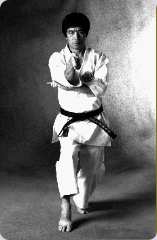 |
Wado-ryu, "way of peace and harmony", founded by by Hironori Ohtsuka, a student of Gichin Funakoshi, in 1939. This style of karate combines basic movements of jujitsu with techniques of evasion, putting a strong emphasis on softness and the way of harmony or spiritual discipline. Wado kai or ryu is one of the four major styles of karate in Japan. Trained in classical bujutsu (the techniques of the samurai), Sensei Ohtsuka applied this outlook and experience to his teachings. Some of the harsher resistive or hard contact elements of sparring technique, typical of many karate styles, are not present in Wado. Sensei Ohtsuka rejected hardening certain parts of the body, such as hand conditioning, as useless preparation. The current head of Wado Kai karate for North America is one of Ohtsuka Sensei's senior students, Sensei Masaru Shintani.
The aim of Wado karate is not merely perfection of the physical techniques of self-defence, but, the development of a mind that is tranquil yet alive, able to react intuitively to any situation. In Wado, as skill and knowledge are acquired through training and concentrated effort, the student is expected to develop inner strength and calmness of character, as well as the virtues of self-control, respect for others, and true humility. Karate-do for Sensei Ohtsuka is primarily a spiritual discipline.
Basic techniques - punching, kicking, blocking, striking with open hand, joint twisting, and trapping techniques - kata and prearranged and free style sparring comprise the training foundation of this style. Equally fundamental to Wado is taisabaki, body shifting to avoid the full brunt of an attack, a technique derived from Japanese swordsmanship. Kumite (sparring) is usually judged on a point system; one referee and four corner judges determine which techniques are given a point. In free sparring, there is no contact allowed to the head, below the waist except for foot sweeps, or to the spine; only light to medium contact is allowed to the torso. Attacks to the head and torso can all score points in a tournament, therefore, Wado karate-ka tend to fight with explosive, close movements with an emphasis on well-controlled techniques.
Note:
It may be noted that Yasutsune "Anko" Itosu and Kanryu Higashionna are the two most important name in the history of modern Karate-do. The four major style of Modern Japanese Karate:- Shito-ryu, Shotokan-ryu, Goju-ryu, and Wado-ryu, can be traced to them .
Kenwa Mabuni (1887-1952), the Shito-ryu founder, was a student of both Yasutsune "Anko" Itosu & Kanryu Higashionna.
Gichin Funakoshi (1886-1957), the Shotokan founder, was a student of Yasutsune "Anko" Itosu (also of Azato).
Chojun Miagi (1888-1953), the Goju-ryu founder, was a student of Kanryu Higashionna.
Hironori Ohtsuka (1892-1982), the Wado-ryu founder, was a student of Gichin Funakoshi, shotokan..
Historical Time and Events
522 - Tamo (Bohidharma) crosses the Himalayas into Fukien province. He teaches the monks 18 `marrow cleansing` exercises improve their physical endurance.
618 - Ch`ueh Yuan Shang-jen revises the original 18 exercises adding 170 offensive and defensive movements creating Ch`uan Fa.
1392 - 36Chinese Families emigrate to Okinawa.
1470 - Okinawa reunites under King Sho Shin, the carrying of weapons is banned.
1609 - The Japanese Satsuma clan invades Okinawa furthering the ban on the use of weapons.
1791 - Kusanku (Kung Syanag) moves to Okinawa. He begins teaching Chuan-Fa.
1882 - Dr. Jigoro Kano founds Judo (Gentle Way) and opens the `Kodokan` school.
1890 - Kanryu Higashionna introduces Naha-te and a breathing exercise called Sanchin.
1903 - Yasutsune "Anko" Itosu begins teaching karate in the Okinawan public school system.
1910 - Kanbun Uechi returns from China, teaching a style of Chinese boxing known as Pangai-Noon (later renamed Uechi-Ryu).
1917 - Gichin Funakoshi goes to Japan to give the first karate demonstration to Japanese royalty.
1920 - Hohan Soken founds the Matsumura Orthodox (Sekunihiashi) style of Shorin-Ryu karate.
1922 - Gichin Funakoshi goes to Japan for a second demonstration, decides to remain there, and begins public teaching of karate (He taught Shorin-Ryu but as he modified it this style was renamed Shotokan; Shoto was his `pen`name and kan means house) Funakoshi is noted as the `Father of Modern Karate` for his efforts in bringing karate into the public eye.
1925 - Morihei Ueshiba founds Aikido (Spirit -Harmony Way).
1928 - Chosin Chibana becomes head of Shorin-Ryu following Itosu`s death. Chibana names his style Kobayashi Shorin-Ryu to designate that it was the same style Itosu had taught. Chogun Miyagi founds the Goju-Ryu (Hard, Soft) system and goes to Japan to teach Karate at Universities.
1930 - Gogen Yamaguchi establishes a Goju-Ryu Headquarters in Tokyo. Kenwa Mabuni goes to Osaka and begins teaching Shito-Ryu (named after Itosu and Higashionna).
1936 - Several karate masters get together and adopt the meaning of 'empty' hand to further the popularity of karate in Japan. In Zoshigaya, Japan the first free-standing karate dojo, `The Shotokan` is established by Gichin Funakoshi.
1945 - 50 Allied occupation following WWII bans the practice and teaching of all martial arts in Japan.
1946 - Mr. Robert Trias opens the first karate studio in the US making him the "Father of American Karate`. His style was Shuri-te.
1947 - Kanei Uechi renames "Pangai-Noon" to "Uechi-Ryu" in honor of his father, Kanbun Uechi, following his death. Shoshin Nagamine founds the Matsubayashi Shorin-Ryu style.
1950 - Gogen Yamaguchi founds the Karate-do Goju-Kai in Tokyo.
1951 - Mas Oyama (known as the `Bull Killer`) founds Kyokushinkai (Peak of Truth) Karate.
1952 - Mas Oyama tours 32 states in the US and introduces karate on a widespread basis to the American public.
1954 - Tatsuo Shimabuku founds Isshin-Ryu (One Heart, Mind and Way). Bruce Lee begins study of Wing Chun in Hong Kong.
1960 - Bruce Lee establishes his first gym in Seattle`s Chinatown.
1967 - Katsuya Miyahira (Shidokan) and Shuguro Nakazato (Shorinkan) inherit the leadership of Kobayashi Shorin-Ryu upon Chosin Chibana's death. Bruce Lee founds Jeet Kune Do (The Way of Intercepting Fist).
1973 - Bruce Lee dies in Hong Kong following an allergic reaction to a Chinese herbal medicine. The Bruce Lee era begins in the US with the release and widespread success of his films. "Enter the Dragon" the first released makes Bruce Lee a superstar and has a tremendous impact on the worldwide popularity of Martial Arts.


 Tweets by @456791084064976896
Tweets by @456791084064976896


